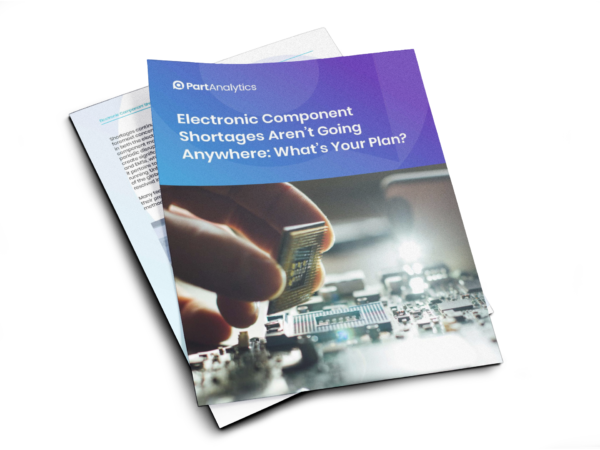Over the past several years, the procurement landscape for OEMs has changed dramatically. Inflationary pressures have grown at an alarming rate, contributing to a marked increase in marketplace instability.
The COVID-19 pandemic caused severe disruptions across the supply chain. For example, a shortage of semiconductors affected entire markets—one industry, automotive manufacturing, had to significantly reduce its production because the chips on which modern vehicles depend simply weren’t available in the required volumes. The natural result of that scarcity was a substantial rise in semiconductor prices.
Even as the pandemic began to abate, the general consumer marketplace was experiencing levels of inflation not seen for decades—by January of 2022 the Consumer Price Index had risen to an annualized rate of 7.5%.
The Impact of Inflation and Shortages on EMS/CMs
As inflation grows throughout the economy, the procurement, labor, and overhead costs of suppliers inevitably rise. Some may resist passing these increases on to customers for a time, but eventually, if the inflation persists, companies at every level in the supply chain will face higher costs.
And inflation is expected to persist. According to a January 2022 PwC Pulse Survey, 68% of US manufacturers expect inflation to remain high throughout 2022. And 57% expect supply chain disruptions to continue over the entire year.
Although OEMs in general are alert to the direct impact of these unsettled conditions on their own operations, there’s another aspect they need to take note of. OEMs have traditionally relied on their contract manufacturers to negotiate for the parts needed in building the OEM’s products. But with inflation growing, and supply chain disruptions causing unanticipated parts shortages, many larger companies haven’t yet realized the impact these forces may be having on their CMs.
The Harvard Business Review highlights the issue this way:
“The resilience of a supply chain is dependent on the reliable performance of the suppliers who make it up, but the fiscal health of many of lower-tier firms is often not visible to executives at companies several tiers up.”
While high inflation and supply chain shortages are critical concerns for OEMs themselves, those conditions can represent an existential crisis for CMs. Because most CMs are smaller businesses than their OEM clients, and have less leverage when negotiating with suppliers, they typically have less ability to obtain favorable pricing and delivery guarantees.
Whether OEMs realize it or not, the inability of their CMs to command the best pricing and availability terms may eventually threaten the OEM’s own control over the costs and production schedules of its products.
How Consolidated Buying Strategies Help Both OEMs and CMs
OEMs have good reasons for avoiding component-level transactions. Leaving such negotiations to their CMs allows OEMs to concentrate on tasks, such as R&D, design, marketing, sales, and customer support, that contribute most directly to a product’s value in the marketplace.
Moreover, CMs sometimes have specialized knowledge that their OEM clients lack. For example, if a CM operates in a low-wage area of the world, it may have a better understanding of the local raw materials marketplace than a global OEM could hope to gain.
Yet, in today’s environment of high inflation and supply chain instability, the traditional OEM practice of leaving procurement negotiations entirely to CMs is becoming less and less viable. As Jithendra Palasagaram, Founder and CEO of Part Analytics, says:
“Historically, the model has been that a lot of the OEMs rely on the CMs to go and do procurement contracts for them. But the market has shifted. As an individual OEM, your spending is split into ten different buckets and ten different companies are going and talking to these component manufacturers. So as an OEM, you’re losing that buying power.”
It’s a simple fact of life that an individual CM that approaches a large component producer, such as an Intel or Texas Instruments, with an order for 100,000 parts, won’t be able to negotiate the same terms for either price or delivery that a global OEM needing 10 million parts across its entire product line can command.
The key to obtaining the best possible deal with parts suppliers is for OEMs to consolidate the procurement requirements of their individual CMs into a single negotiating package. That’s what consolidated buying is all about
Key Benefits of a Consolidated Buying Strategy for Supplier Relationships
When an OEM teams up with its CMs to institute consolidated buying it can expect benefits such as:
- Better understanding of, and greater control over, its entire procurement process
- Better component prices due to volume buying
- Lower transaction costs because fewer individual transactions are required
- Greater leverage to negotiate strong delivery guarantees, reducing the risk of supply disruptions
- Ability to spot single-source supply situations, and reduce risk by developing a comprehensive multi-source supply chain
- Ability to update a product’s design, incorporating different components or newer technologies, in response to changes in the availability or costs of existing BOM items
Implementing a Consolidated Buying Strategy
Implementing a consolidated buying system requires close cooperation between an OEM and its CM partners.
First, the OEM must aggregate its own demand across the company for each item included in its products’ BOMs. Because the needed data usually isn’t available in a single location, it normally must be collected from a variety of sometimes incompatible sources.
For example, the BOM specifying the components that go into a printed circuit board assembly is most likely maintained in the OEM’s PLM system. But usage forecast information for that PCBA part number may reside in the ERP system. Also, a particular component may be included on different PCBAs. So, to calculate aggregated demand for each PCB component included in all of the company’s products, you need a tool that can consolidate all these sources into a single stream of compatible data.
In many cases, OEMs have visibility only to the level of an assembly part number, and may not retain information concerning lower-level components. That means OEMs must go to their CMs to obtain the component-level data required for understanding aggregate demand. The CM should be able to say which components they are buying, in what quantities, from whom, at what price, and under what terms.
In some cases, CMs are reluctant to provide such information to OEMs due to concerns about revealing their materials, direct labor and overhead costs, or their profit margins. Similarly, some resist disclosing the terms of their agreements with suppliers. That’s why the first requisite for a successful consolidated buying partnership is for OEMs to establish relationships of mutual trust and benefit with their CMs.
To build that kind of trust, OEMs need to be open with CMs, giving them insight not just into what the OEM wants to buy currently, but also how the CM will be included in plans for new products in the pipeline.
Ultimately, the OEM must be able to ask for detailed, itemized, line-item CBOMs without the CM feeling threatened. It must be clear that the consolidated buying partnership will be a win-win situation for both.
New Technology Finally Makes Consolidated Buying a Viable Option
The information demands of a consolidated buying system are great, and won’t be met by essentially manual tools such as Excel spreadsheets. But new supply chain-specific software solutions are making the task easier than ever.
For example, the sophisticated, AI-based, SaaS platform offered by Parts Analytics can automatically and intelligently search for all the parts and alternative options on an OEM’s BOMs, while aggregating and rationalizing data from other internal and external sources.
With such tools available, and with the prospect that high inflation and supply chain disruptions will continue into the indefinite future, now is the time for forward-looking OEMs to make consolidated buying a profitable reality for both themselves and their CMs.





